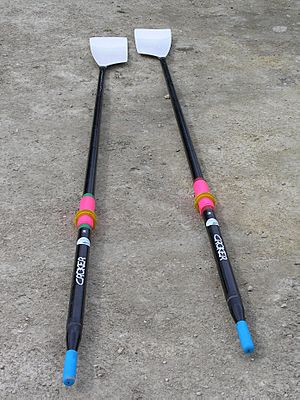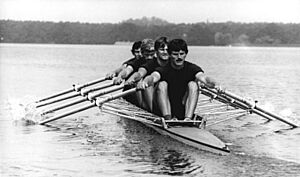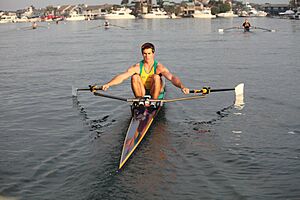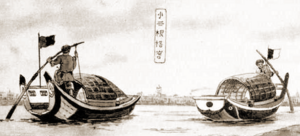Sculling facts for kids
Sculling is a way to move a boat using oars. You can do this by using two oars, one on each side of the boat. Or, you can use just one oar at the back of the boat. When people talk about sculling, they might also call the oars themselves "sculls." Sometimes, even the boat itself is called a "scull."
Contents
Two-Oar Sculling: Moving with Two Oars
Two-oar sculling is a type of rowing. In this style, each rower uses two oars, one in each hand. This is different from sweep rowing, where each rower uses both hands to control just one oar. That single oar is on either the left (port) or right (starboard) side of the boat. Sculling is often seen as more challenging to learn than sweep rowing.
You can do two-oar sculling for fun or in competitions. The boats used for racing are called racing shells. They are built for speed, not for being super stable. Racing shells are also much more expensive and delicate than boats for casual rowing. A racing shell can cost thousands of dollars. Recreational sculling boats are usually much cheaper.
Two-Oar Sculling in Competitive Rowing
Sculling is one of the two main types of competitive rowing, also called "crew." Races happen between small boats that are moved by sculling. These boats usually have one, two, or four rowers.
- Single sculls have one rower.
- Double sculls have two rowers.
- Quad sculls have four rowers.
Sometimes, a quad boat might be rowed by three people if there aren't enough rowers. A very rare sculling boat is the octuple, which has eight rowers. Big rowing teams sometimes use octuples to teach new rowers how to scull in a stable boat that has a coxswain.
The way you move the boat in sculling has two main parts:
- The drive: This is when the oars are firmly in the water. The rower pulls against the water to push the boat forward.
- The recovery: This is when the oars are out of the water. They glide above the water as the rower gets ready for the next stroke.
These two parts are separated by the "catch" and the "finish."
- The catch: This is the moment the oars enter the water. It happens at the end of the recovery and the start of the drive.
- The finish: This is when the oars leave the water. It happens after the drive and before the recovery begins.
To help with balance during the recovery, the oar blades are "feathered." This means they are held flat, parallel to the water's surface. At the catch, they are "squared," meaning they are straight up and down, ready to push water.
In competitive crew, all rowers need to match the rhythm and movements of the rower closest to the back of the boat. This rower is called the "stroke seat." Sometimes, a boat has a coxswain, or "cox." The coxswain steers the boat, encourages the team, and keeps track of the speed. However, in sculling boats, coxswains are very rare. Instead, the rower at the front of the boat (the "bow seat") usually handles these jobs. The bow rower might have special equipment to help steer the boat. Without it, a sculling boat is steered by pushing harder on one oar than the other.
One important difference between sculling and sweep rowing is how the oar handles move. In sculling, the handles of the two oars cross over each other twice during a stroke. This doesn't happen in sweep rowing because each rower only uses one oar. Because the sculling oar handles overlap, scullers must hold one hand (usually the left hand) higher than the other when they cross. To keep the boat balanced, one oarlock (the part that holds the oar) is set a bit higher than the other. This stops the oar handles from hitting each other and causing problems.
Single-Oar Sculling: Moving with One Oar
Single-oar sculling is a way to move a boat using just one oar at the back. You move this single oar from side to side. As you move it, you change the angle of the blade. This creates forward push on both the push and pull parts of the stroke. This technique is very old. No one knows exactly where it started, but it probably developed in different places around the world. It was used in ancient China and by Native Americans on the Great Lakes.
In single-oar sculling, the oar pivots on a small notch or holder at the back of the boat. The rower pushes the inside end of the oar to one side. They twist the blade so it pushes the boat forward. Then, they twist it again as they pull it back, so it still pushes the boat forward. You can also push the boat backward by twisting the oar the other way. Steering the boat is done by changing how much push you get from the oar. The oar normally rests in a simple notch. The sculler must angle the blade by twisting the oar. This not only pushes the boat forward but also keeps the oar in its pivot point. The oar blade moves in a figure-8 pattern. It's not lifted in and out of the water like other oars. The goal is to move your hands as little as possible. This makes the boat move slowly and smoothly through the water.
China
The Chinese "yuloh" (pronounced yaolu) is a large, heavy sculling oar. It has a special part on its underside that fits over a pin at the back of the boat. This pin lets the oar swivel and rock from side to side. The weight of the oar, sometimes with a rope, keeps it in place. A rope from the oar's handle to the boat's deck helps balance the oar's weight. The sculler mostly moves the oar by pushing and pulling this rope. This makes the oar rock and automatically angles the blade to create forward push. This system is so good that several rowers can operate one oar. This allows large, heavy boats to be moved. The Chinese have a saying: "a scull equals three oars," because it's so efficient.
Single-Oar Sculling in Competitive Rowing
Single-oar sculling can also happen in competitive rowing. For example, when a sweep boat is lined up at the start of a race, the coxswain might need to adjust the boat's direction. To do this without moving the boat away from the starting line, the coxswain will tell a rower in the front half of the boat to "scull" the oar of the rower behind them. By doing this, the coxswain can change the boat's direction without leaving the starting line.
Modern Single-Oar Sculling
Today, single-oar sculling boats come in many shapes and sizes. They can be traditional cargo boats, fishing boats, or just simple boats for fun. They often have an oar holder mounted on one side. This allows the person operating the boat to use just one hand. A big reason people like these boats is that they are easy and cheap to use. Modern boats are made from wood, fiberglass, concrete, or metal. Some are even old motorboats that have been changed.
Smaller sculling boats are great for hunting. The person operating the boat can sneak up on fish and birds very quietly. They don't make splashes or disturb the calm water. Newer hunting boats that use single sculling are made from very light materials. They have sleek shapes for more speed and better control. These modern single sculling oars are usually mounted to pivot off one side of the boat. The person can face either forward or backward.
Sculling in Swimming
"Sculling" can also describe a special swimming drill. In this drill, a swimmer uses their arms and hands to move forward or backward in the water. The swimmer is usually face-down. Their arms might be stretched above their head or down by their hips. In this position, the swimmer moves their cupped hands back and forth. To move backward, they point their wrists down and palms forward. To move forward, they slightly lift their wrists and point their palms slightly back.





